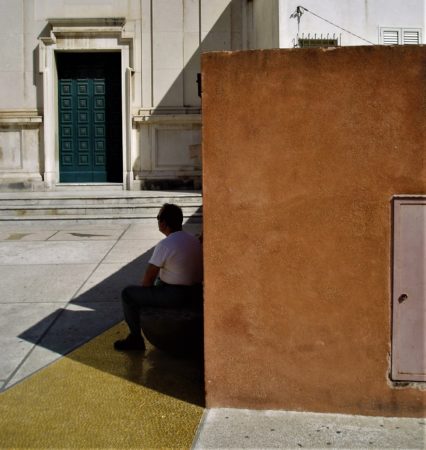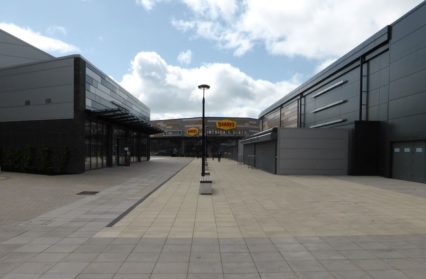Richard Porch explores the timeless quality of the stillness of the urban environment.
Stillness as a quality is almost inimical to cities. Like humans they are almost never inactive unless dead or in some sense moribund. True, the diurnal nature of the daily cycle naturally makes them less busy at certain times and busier at others depending on the nature of the activities being carried on in them. Most often it is people and their transportation infrastructure that tends to energise a city and make it appear active, alive and pulsing with life. Subtract people and it is left to architecture and the spaces between it to create atmosphere. If you’ve ever walked through a major city late at night or in the early morning, you’ll know how disconcerting it can be when there is so much stillness around you. It can be simultaneously life-enhancing and menacing.

Interestingly, stillness can make itself felt in the countryside or in gardens. This sounds odd given that nature is manifestly alive on so many levels with the life that permeates it. Clouds scud silently across otherwise empty skies driven by invisible zephyrs of wind. Statuesque lines of gently swaying trees frame landscapes while hedges and fields teem with wildlife doing its best to survive whilst avoiding becoming part of the food chain before it was absolutely necessary. A decent fall of snow can induce stillness (and muffle sound as a bonus) as can a freezing cold day or paradoxically an extremely hot one. So, climate and the weather can encourage stillness too. I’ve seen this work to great effect in the gardens of the Villa Cimbrone at Ravello in Italy. For here in a classically beautiful formal garden with its origins in the 11th century AD, ornaments and statuary combine to produce moments that gently stop you in your tracks. The sheer stillness actually stops you snapping away with the camera and / or gabbling to companions. Perhaps it is that very stillness that makes trying to photograph it redundant. The moment is graspable or palpable and so one doesn’t need to try and trap it photographically. One still does of course.
I’ve felt this work on the most unexpected of occasions. I once stopped near a field in Oxfordshire on a freezing cold and windless January afternoon when the clouds were just hanging there like smudges of white pastel and the bare hedges were just a thicket of cruel spiny branches. Bare fields tinged with a blush of green were interrupted by tractor tyre marks that ran away enigmatically to the horizon. A distant treeline was represented by nothing more than a smudgy haze that seemed to have been created by someone who had grazed it hurriedly with a stick of charcoal. Of course the sky was moving, albeit imperceptibly and yet the moment was held perfectly still for me to contemplate on that cold mid-winter’s day. There was no focal point as such and yet I could have stood in front of it for ages. Photographically it was almost a perfect ‘rule of thirds’ composition with the sky, landscape and foreground of hedge operating equally to provide a visual balance. Perhaps subliminally was it this that held me? Or was it that it made me think of old watercolour landscape paintings by artists from the Norwich School of painters like John Sell Cotman (1782 – 1842) who actually came to paint in Wales between 1800-01 or John Middleton (1827 – 1856). Works such as ‘A Ploughed Field’ (circa 1805) and ‘A Fine Day in February’ (undated) which took superficially unprepossessing views of the landscape and by dint of an elegant watercolour technique transformed them into works you could stare into for ages.
Finally, stillness in cities occurs most often in proximity to architecture and the spaces between it. This also the case when people and traffic are excluded. This sounds like a very obvious thing to say and it is. Not having to negotiate busy roads and streams of one’s fellow travellers seems to remove a number of filters on our perception of the city. One can at last appreciate its monumentality or the very absence of it. This way shadows become simultaneously dramatic and off-putting – do we want to venture into them – what do they harbour? Their very porosity at odds with a seemingly impenetrable blackness. Stillness is a great friend of architecture because it enables buildings to be considered free from distraction. When the city is still, a building can be regarded in almost the same considered way as its architect imagined it in a pre-construction perspective. Before they added the patronising content of people, cars and strategically placed trees and landscaping.
The sheer buzz of urban life around most buildings does them no favours unless they are of the steel and mirror glass vernacular. Then the distorted movement of people shimmering across large sheets of class qualifies its elevations as ‘kinetic’ and therefore ‘friendly’.
Surely the greatest artist who could unerringly capture the essence of ‘stillness’ in a city was Edward Hopper (1882 – 1967). His work, so often considered voyeuristic, showed people in settings where a certain kind of stillness has settled pregnantly on them. Customers at a late-night diner such as Nighthawks (1942) or the theatre usherette in New York Movie (1939) perfectly demonstrates how pools of stillness can open up or be self-created in even the most crowded urban places. This is a stillness not born merely of location, rather it is people (either collectively or individually) bringing it into existence. This tends to confirm the axiom that ‘people create places – places don’t create places’. Hopper’s urban paintings of people in apartments or offices – often seen from a slightly kinky viewpoint from outside the building – are knowingly saturated with an unreconciled drama for which no explanation is offered. There is a disturbing stillness at work, along with an unspoken question which just hangs there in the air, why is the artist showing us this? The resultant friction generated is exacerbated by a prevailing lack of activity which suggests that something is about to happen or has already happened and we are just looking at the aftermath. One would have thought that Hopper might have been better off capturing such moments with a camera. But this would have been truly voyeuristic and not an artistic statement. The painterly style, you couldn’t call Hopper’s work hyper-real, makes no attempt to disguise the fact you are looking at a painting and not the pickled reality of a black and white photograph. Nevertheless, one is still drawn into the psychodrama of a Hopper artwork. The reason for that I suspect is that he is very knowledgeably tapping into the real or imagined existential dramas provided by urban life. In his work we are continually asking ourselves what are the people thinking, who are they and (above all) what will happen next? What indeed; by not providing any clues to resolution the tableaux become a troubling enigma.
Stillness in cities can produce that same feeling which teeters between the life-enhancing and the sinister, keep a watch out for it. Capturing it in a photograph is more difficult than it seems as stillness can often be mistaken for the mundane.
All images by the author.












